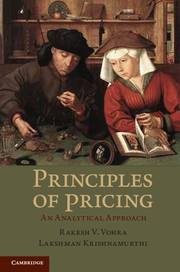6 - Price Discrimination
Published online by Cambridge University Press: 05 June 2012
Summary
It is not uncommon for different customers to value the same product differently. This difference in valuation allows one to earn a greater profit by matching the price to a customer's RP – in other words, selling the same product or service to different buyers at different prices. In many cases, some modification of the product or service is needed to be able to charge different prices. The practice is called price discrimination. To see why the practice is more profitable than charging a uniform price, an example is helpful.
Example 14 Recall the monopolist from Example 3 in Chapter 4. The demand for the monopolist's product is described by the demand curve 9 – p. Such a curve can arise in the following way: Suppose there is one customer with a R P of 8, another with a RP of 7, and so on. When the monopolist was restricted to charging a single price, we determined that the price should be $5 a unit, yielding a profit of $16. Suppose the monopolist could get away with charging a different price to each buyer, say, $7 to the buyer with a R P of $8, $6 to the buyer with a RP of $7, and so on until the buyer with a R P of $2. The profit would be 6 + 5 + 4 + 3 + 1 = 19. □
- Type
- Chapter
- Information
- Principles of PricingAn Analytical Approach, pp. 106 - 158Publisher: Cambridge University PressPrint publication year: 2012



